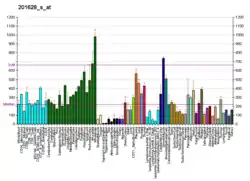RRAGA
Ras-related GTP-binding protein A is a protein that in humans is encoded by the RRAGA gene.[5][6][7]
References
- GRCh38: Ensembl release 89: ENSG00000155876 - Ensembl, May 2017
- GRCm38: Ensembl release 89: ENSMUSG00000070934 - Ensembl, May 2017
- "Human PubMed Reference:". National Center for Biotechnology Information, U.S. National Library of Medicine.
- "Mouse PubMed Reference:". National Center for Biotechnology Information, U.S. National Library of Medicine.
- Schürmann A, Brauers A, Massmann S, Becker W, Joost HG (Dec 1995). "Cloning of a novel family of mammalian GTP-binding proteins (raga d, RagBs, RagB1) with remote similarity to the Ras-related GTPases". The Journal of Biological Chemistry. 270 (48): 28982–8. doi:10.1074/jbc.270.48.28982. PMID 7499430.
- Li Y, Kang J, Horwitz MS (Feb 1997). "Interaction of an adenovirus 14.7-kilodalton protein inhibitor of tumor necrosis factor alpha cytolysis with a new member of the GTPase superfamily of signal transducers". Journal of Virology. 71 (2): 1576–82. doi:10.1128/JVI.71.2.1576-1582.1997. PMC 191215. PMID 8995684.
- "Entrez Gene: RRAGA Ras-related GTP binding A".
- Sekiguchi T, Todaka Y, Wang Y, Hirose E, Nakashima N, Nishimoto T (Feb 2004). "A novel human nucleolar protein, Nop132, binds to the G proteins, RRAG A/C/D". The Journal of Biological Chemistry. 279 (9): 8343–50. doi:10.1074/jbc.M305935200. PMID 14660641.
- Rual JF, Venkatesan K, Hao T, Hirozane-Kishikawa T, Dricot A, Li N, Berriz GF, Gibbons FD, Dreze M, Ayivi-Guedehoussou N, Klitgord N, Simon C, Boxem M, Milstein S, Rosenberg J, Goldberg DS, Zhang LV, Wong SL, Franklin G, Li S, Albala JS, Lim J, Fraughton C, Llamosas E, Cevik S, Bex C, Lamesch P, Sikorski RS, Vandenhaute J, Zoghbi HY, Smolyar A, Bosak S, Sequerra R, Doucette-Stamm L, Cusick ME, Hill DE, Roth FP, Vidal M (Oct 2005). "Towards a proteome-scale map of the human protein-protein interaction network". Nature. 437 (7062): 1173–8. doi:10.1038/nature04209. PMID 16189514. S2CID 4427026.
- Sekiguchi T, Hirose E, Nakashima N, Ii M, Nishimoto T (Mar 2001). "Novel G proteins, Rag C and Rag D, interact with GTP-binding proteins, Rag A and Rag B". The Journal of Biological Chemistry. 276 (10): 7246–57. doi:10.1074/jbc.M004389200. PMID 11073942.
Further reading
- Hirose E, Nakashima N, Sekiguchi T, Nishimoto T (Jan 1998). "RagA is a functional homologue of S. cerevisiae Gtr1p involved in the Ran/Gsp1-GTPase pathway". Journal of Cell Science. 111 ( Pt 1) (1): 11–21. PMID 9394008.
- Sekiguchi T, Hirose E, Nakashima N, Ii M, Nishimoto T (Mar 2001). "Novel G proteins, Rag C and Rag D, interact with GTP-binding proteins, Rag A and Rag B". The Journal of Biological Chemistry. 276 (10): 7246–57. doi:10.1074/jbc.M004389200. PMID 11073942.
- Sekiguchi T, Todaka Y, Wang Y, Hirose E, Nakashima N, Nishimoto T (Feb 2004). "A novel human nucleolar protein, Nop132, binds to the G proteins, RRAG A/C/D". The Journal of Biological Chemistry. 279 (9): 8343–50. doi:10.1074/jbc.M305935200. PMID 14660641.
- Rual JF, Venkatesan K, Hao T, Hirozane-Kishikawa T, Dricot A, Li N, Berriz GF, Gibbons FD, Dreze M, Ayivi-Guedehoussou N, Klitgord N, Simon C, Boxem M, Milstein S, Rosenberg J, Goldberg DS, Zhang LV, Wong SL, Franklin G, Li S, Albala JS, Lim J, Fraughton C, Llamosas E, Cevik S, Bex C, Lamesch P, Sikorski RS, Vandenhaute J, Zoghbi HY, Smolyar A, Bosak S, Sequerra R, Doucette-Stamm L, Cusick ME, Hill DE, Roth FP, Vidal M (Oct 2005). "Towards a proteome-scale map of the human protein-protein interaction network". Nature. 437 (7062): 1173–8. doi:10.1038/nature04209. PMID 16189514. S2CID 4427026.
This article is issued from Wikipedia. The text is licensed under Creative Commons - Attribution - Sharealike. Additional terms may apply for the media files.




